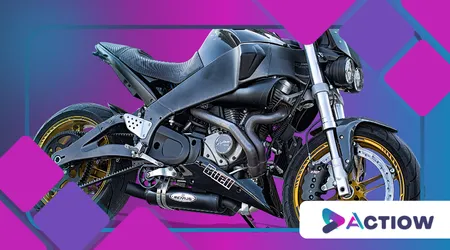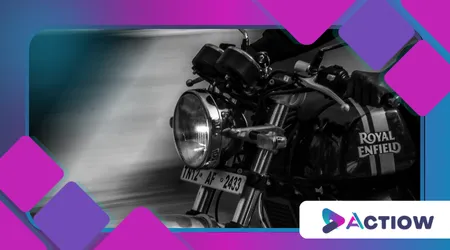The Evolution of Motorcycle Technology
Anúncios
Evolution of Motorcycle Technology!
The motorcycle, a symbol of freedom and raw power, has undergone a remarkable transformation since its inception in the late 19th century.
Far from being a mere mode of transport, it has evolved into a marvel of engineering, blending cutting-edge technology with human ingenuity.
Anúncios
The evolution of motorcycle technology is not just a story of mechanical advancements but a reflection of humanity’s relentless pursuit of efficiency, safety, and exhilaration.
Evolution of Motorcycle Technology

How has this two-wheeled icon adapted to the demands of modern riders while staying true to its rebellious roots?
This journey spans from rudimentary steam-powered cycles to electric powerhouses that rival their gas-guzzling ancestors.
Each era has introduced breakthroughs that have redefined what motorcycles can achieve.
Consequently, understanding this evolution offers insight into how innovation shapes culture, industry, and even environmental consciousness.
This article delves into the pivotal moments in motorcycle technology, exploring key advancements, their impacts, and what lies ahead.
++ Solid-State Batteries in Cars: What You Need to Know in 2025
Through a blend of historical analysis, modern examples, and forward-thinking speculation, we uncover why the evolution of motorcycle technology remains a dynamic force in engineering and design.
Early Beginnings: The Birth of the Motorcycle

The dawn of the motorcycle can be traced back to 1867, when Sylvester Roper unveiled his steam-powered velocipede.
This contraption, though primitive, laid the groundwork for what would become a global phenomenon.
Unlike modern motorcycles, early designs were little more than bicycles fitted with bulky engines, often unreliable and cumbersome.
Nevertheless, they sparked curiosity, setting the stage for rapid innovation.
++ Real-World Range Test: Top 5 Affordable EVs Compared
By 1885, Gottlieb Daimler and Wilhelm Maybach introduced the Reitwagen, widely considered the first true motorcycle.
Powered by a single-cylinder internal combustion engine, it achieved a top speed of 11 km/h a modest feat by today’s standards but revolutionary at the time.
This leap forward, however, came with challenges: poor roads, rudimentary materials, and limited engineering knowledge meant that early motorcycles were more experimental than practical.
Yet, these pioneers demonstrated that two-wheeled vehicles could be more than novelties.
The early 20th century saw manufacturers like Harley-Davidson and Indian Motorcycle refine the concept.
For instance, the introduction of V-twin engines in the 1910s offered greater power and reliability, enabling motorcycles to transition from curiosities to viable transport.
These advancements, coupled with growing consumer interest, cemented the motorcycle’s place in society, paving the way for further technological leaps.
The Mid-20th Century: Power and Performance
As the world entered the mid-20th century, motorcycles began to embody speed and style.
++ Tesla Model 3 vs BYD Seal: Which EV Offers More Value in 2025?
Post-World War II, manufacturers leveraged wartime engineering advancements to enhance performance.
For example, the 1948 Vincent Black Shadow, a British marvel, boasted a 998cc V-twin engine capable of reaching 125 mph an astonishing feat for its era.
This bike exemplified how the evolution of motorcycle technology prioritized raw power, appealing to thrill-seekers and racers alike.
Meanwhile, Japanese manufacturers like Honda, Yamaha, and Kawasaki entered the scene, democratizing motorcycling with affordable, reliable models.
Honda’s 1969 CB750, often hailed as the first “superbike,” introduced a four-cylinder engine, disc brakes, and an electric starter features that set a new standard for performance and accessibility.
This shift not only broadened the market but also spurred competition, driving innovation at an unprecedented pace.
Safety, too, began to take center stage.
The introduction of hydraulic disc brakes in the 1970s, for instance, improved stopping power significantly.
Additionally, advancements in suspension systems, such as telescopic forks, enhanced handling on diverse terrains.
These developments underscored a critical truth: performance without safety is unsustainable.
Thus, the mid-20th century marked a turning point where motorcycles became both exhilarating and practical.
The Digital Age: Electronics and Precision
Fast forward to the late 20th and early 21st centuries, and the evolution of motorcycle technology entered the digital realm.
The integration of electronics transformed motorcycles into sophisticated machines.
For example, Bosch’s introduction of Anti-lock Braking Systems (ABS) in the 1980s revolutionized safety by preventing wheel lock-up during sudden stops.
Today, ABS is standard on many models, reducing crash rates by an estimated 31%, according to a 2018 study by the Insurance Institute for Highway Safety.
Moreover, ride-by-wire technology, first popularized in the 2000s, allowed precise throttle control through electronic signals rather than mechanical cables.
This innovation enabled features like traction control and multiple riding modes, tailoring performance to conditions or rider preferences.
Take the 2015 Yamaha R1: its suite of electronic aids, including slide control and engine braking management, made it a track-ready machine accessible to everyday riders.
This fusion of electronics and engineering exemplifies how technology enhances both safety and performance.
Beyond performance, digital dashboards and connectivity have redefined the rider experience.
Modern motorcycles, like the BMW R1250GS, feature TFT displays with GPS, smartphone integration, and real-time diagnostics.
These advancements reflect a broader trend: motorcycles are no longer just vehicles but interconnected platforms that blend engineering with user-centric design.
As a result, riders enjoy unprecedented control and convenience, marking a new chapter in the evolution of motorcycle technology.
The Electric Revolution: Sustainability Meets Speed
The 21st century has ushered in a seismic shift with the rise of electric motorcycles.
Unlike their gas-powered predecessors, electric bikes offer instant torque, silent operation, and zero emissions a trifecta that aligns with growing environmental concerns.
Companies like Zero Motorcycles and Harley-Davidson’s LiveWire have pioneered this space, proving that electric power can rival traditional engines.
For instance, the Zero SR/F delivers 140 ft-lbs of torque, outpacing many gas-powered superbikes in acceleration.
This transition, however, isn’t without hurdles.
Battery range remains a limiting factor, with most electric motorcycles offering 100-200 miles per charge.
Yet, advancements in lithium-ion technology and fast-charging infrastructure are closing the gap.
Consider the analogy of a smartphone: just as early mobile phones were bulky with limited battery life, modern electric motorcycles are rapidly improving, promising a future where range anxiety is a relic of the past.
Additionally, electric motorcycles are redefining design paradigms.
Without bulky engines, manufacturers can experiment with sleeker frames and innovative layouts.
The Super73-ZX, an electric urban bike, blends retro aesthetics with modern tech, appealing to a new generation of riders.
Thus, the electric revolution not only addresses environmental concerns but also expands the cultural footprint of motorcycling, making it more inclusive and forward-thinking.
The Future: Autonomy and Beyond
What does the future hold for the evolution of motorcycle technology?
Emerging trends point to autonomous features, artificial intelligence, and advanced materials.
For instance, BMW’s Motorrad Vision Next 100 concept, unveiled in 2016, envisions a self-balancing motorcycle that eliminates the need for a kickstand and reduces crash risks.
While full autonomy may seem far-fetched, semi-autonomous features like adaptive cruise control are already appearing in models like the 2021 Ducati Multistrada V4.
Furthermore, lightweight materials such as carbon fiber and titanium are reducing weight while enhancing durability.
These materials, once exclusive to high-end models, are becoming more accessible, improving efficiency across the board.
Meanwhile, AI-driven diagnostics can predict maintenance needs, extending the lifespan of components.
This convergence of technologies raises a provocative question: will motorcycles eventually outsmart their riders, or will they remain a testament to human control?
The integration of augmented reality (AR) also looms large. Imagine a helmet with an AR visor displaying real-time navigation, speed, and hazard warnings directly in the rider’s field of vision.
Companies like NUVIZ are already prototyping such systems, signaling a future where motorcycles are as much about information as they are about motion.
Consequently, the evolution of motorcycle technology is poised to redefine not just how we ride but how we interact with the world.
Challenges and Ethical Considerations

Innovation, while exciting, brings challenges.
The shift to electric motorcycles, for instance, raises questions about battery production and disposal.
Mining lithium and cobalt often involves environmental and ethical concerns, including habitat destruction and labor exploitation.
Manufacturers must address these issues to ensure that the evolution of motorcycle technology aligns with sustainability goals.
Moreover, the rise of autonomous features sparks debate about the essence of motorcycling.
For many, the thrill lies in the rider’s skill and connection to the machine.
If motorcycles become too automated, will they lose their soul?
Balancing technological advancement with the visceral joy of riding is a delicate task, one that manufacturers like Yamaha and KTM are navigating by prioritizing rider-centric designs.
Finally, accessibility remains a hurdle.
Advanced technologies, from ABS to AR helmets, often come with premium price tags, limiting their reach.
As the industry evolves, democratizing these innovations will be crucial to ensure that motorcycling remains a universal passion, not an elite privilege.
Thus, the evolution of motorcycle technology must consider inclusivity alongside innovation.
Evolution of Motorcycle Technology: Frequently Asked Questions
The following table addresses common queries about the evolution of motorcycle technology, providing concise, informed answers to guide enthusiasts and newcomers alike.
| Question | Answer |
|---|---|
| What was the first motorcycle? | The 1885 Daimler Reitwagen, powered by a single-cylinder engine, is considered the first true motorcycle, achieving speeds up to 11 km/h. |
| How have electric motorcycles impacted the industry? | Electric motorcycles, like those from Zero and LiveWire, offer zero emissions and instant torque, pushing the industry toward sustainability while maintaining high performance. |
| Are autonomous motorcycles a reality? | Semi-autonomous features like adaptive cruise control exist, but fully autonomous motorcycles are still conceptual, as seen in BMW’s Vision Next 100. |
| How do electronics improve motorcycle safety? | Technologies like ABS and traction control reduce crash risks by 31% (IIHS, 2018) and enhance rider control in varied conditions. |
| What are the challenges of electric motorcycles? | Limited range (100-200 miles), high costs, and ethical concerns around battery production are key challenges, though advancements are addressing these. |
Conclusion: Evolution of Motorcycle Technology
The evolution of motorcycle technology is a testament to human creativity, blending mechanical prowess with digital innovation.
From steam-powered curiosities to electric marvels, motorcycles have adapted to changing times while retaining their allure.
As we look to the future, the integration of AI, lightweight materials, and sustainable practices promises to push boundaries further.
Yet, the challenge lies in preserving the essence of motorcycling freedom, thrill, and connection while embracing progress.
As riders, engineers, and dreamers, we stand at the cusp of a new era, ready to accelerate into the unknown.
